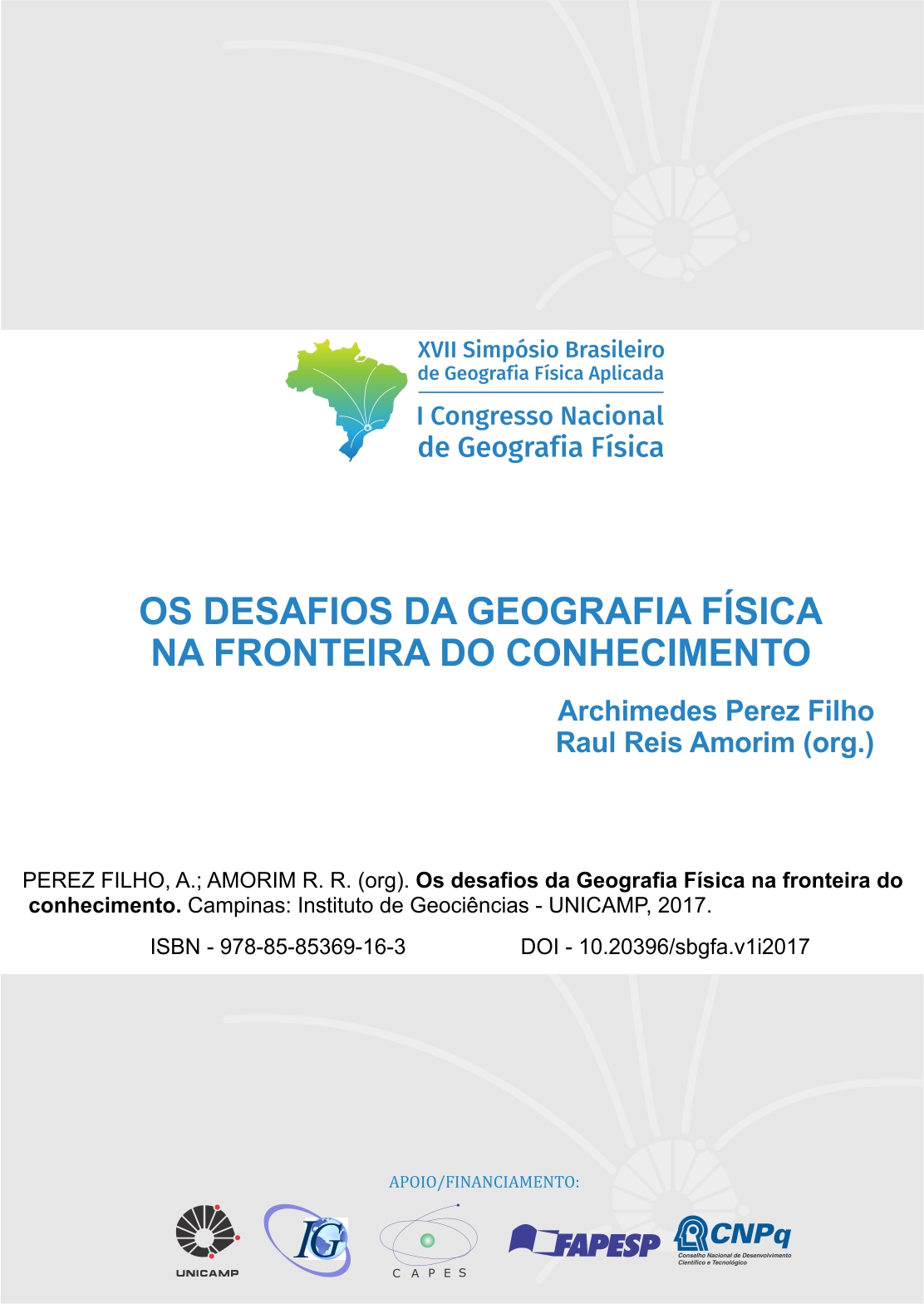Análise microclimática de manguezais em Unidades de Conservação de Proteção Integral e de Uso Sustentável
DOI:
https://doi.org/10.20396/sbgfa.v1i2017.2054Palavras-chave:
Atributos climáticos. Mangue. Áreas protegidas. MonitoramentoResumo
Os manguezais ocorrem ao longo de gradientes ambientais em diferentes escalas de atuação. Entender as respostas ecofisiológicas dos manguezais diante desses gradientes é de suma importância para sua conservação. No litoral sul de São Paulo, o microclima vem sendo estudado como um indicador de alterações que estão ocorrendo na estrutura do manguezal, em sua borda e no interior de seu ecossistema. O presente trabalho apresenta análise e comparação dos atributos climáticos temperatura do ar, radiação solar e precipitação em manguezais do litoral sul do estado de São Paulo, em Unidades de Conservação de Uso Sustentável e de Proteção Integral: Área de Proteção Ambiental Cananéia-Iguape-Peruíbe (APACIP) e Parque Estadual da Ilha do Cardoso (PEIC), repectivamente. Constatou-se que as UCs de Proteção Integral tem papel fundamental na manutenção do bom estado de conservação dos manguezais do litoral sul de São Paulo e consequentemente de seus serviços ecossistêmicos relacionados à estabilização do microclima.
Referências
ALONGI, D. M. Present state and future of the world’s mangrove forests. Environmental Conservation 29 (3): 331–349. 2002.
Foundation for Environmental Conservation.
ALONGI, D. M. Mangrove forests: Resilience, protection from tsunamis, and responses to global climate change. Estuarine, Coastal and Shelf Science. v. 76, p. 1–13. 2008.
ALONGI, D. M. The energetics of mangrove forests. Queensland: Springer Science, 2009. 216 p.
BESERRA DE LIMA, N. G.; GALVANI, E. Mangrove Microclimate: A Case Study from Southeastern Brazil. Earth Interactions, v. 17, p. 1, 2013.
CUNHA-LIGNON, M.; KAMPEL, M.; MENGHINI, R.P.; SCHAEFFER-NOVELLI, Y.; CINTRÓN, G.; DAHDOUH-GUEBAS, F., 2011. Mangrove Forests Submitted to Depositional Processes and Salinity Variation Investigated using satellite images and vegetation structure surveys. Journal of Coastal Research, SI 64, v. I, p. 344-348.
CUNHA-LIGNON, M.; ALMEIDA, R.; LIMA, N.G.B.; GALVANI, E.; MENGHINI, R.P.; COELHO-JR., C.; SCHAEFFER-NOVELLI, Y., 2015. Monitoramento de Manguezais: abordagem integrada frente às alterações ambientais. Anais... VIII CBUC - Trabalhos Técnicos, Curitiba, 1-17.
DUKE, N.C.; MEYNECKE, J.-0.; DITTMANN, A.M.; ELLISON, A.M.; AANGER, K.; BERGER, U.; CANNICCI, S.; DIELE, K.; EWEL, K.C.; FIELD, C.D.; KOEDAM, N.; LEE, S.Y.; MARCHAND, C.; NORDHAUS, I.; DAHDOUH-GUEBAS, F., 2007. A world without mangroves? Science, 317: 41-42.
GALVANI, E.; LIMA, N. G. B., Estudos climáticos nas escalas inferiores do clima: manguezais da Barra do Rio Ribeira, Iguape, SP. Revista Mercator, 9 (1), 25-38, 2010.
GIRI, C.; Ochieng, E; TIESZEN, L.L; DUKE, N. Status and distribution of mangrove forests of the world using earth observation satellite data. Global Ecology and Biogeography, 2011. 20, 154–159.
KRAUSS, K.; DOYLE T.; DOYLE, T.; SWARZENSKI, C; FROM, A.; DAY, R.; CONNER, W. Water level observations in mangrove swamps during two hurricanes in Florida. Wetlands, Vol. 29, No. 1, March 2009, pp. 142–149.
LACAMBRA, C.; SPENCER, T.; MOELLER, I. Tropical coastal ecosystems as coastal defences. ProAct Network, Unitec Kingdom, p. 1-22, 2008.
LIMA, N.G.B. DE, GALVANI, E.; CUNHA-LIGNON, M.. Air temperature and canopy cover of impacted and conserved mangrove ecosystems: a study of a subtropical estuary in Brazil. Journal of Coastal Research, Special Issue No. 65, 2013.
LUGO, A.E.; MEDINA, E.; MCGINLEY, K. Issues and challenges of Mangrove conservation in the Anthropocene. Madera y Bosques vol. 20, núm. especial : 11-38 2014
MAGRIS, R.A.; BARRETO, R. Mapping and assessment of protection of mangrove habitats in Brazil. Pan-American Journal of Aquatic Sciences (2010), 5(4):546-556
MAHIQUES, M.M.; BURONE, L.; FIGUEIRA, R.C.L.; LAVENÉRE-WANDERLEY, A.A.O.; CAPELLARI, B.; ROGACHSKI, C.E.; BARROSO, C.P.; SANTOS, L.A.S.; CORDERO, L.M.; CUSSIOLI, M.C., 2009. Anthropogenic influences in a lagoonal environment: a multiproxy approach at the Valo Grande Mouth, Cananéia-Iguape System (SE Brazil). Brazilian Journal of Oceanography, 57(4), 325-337.
MAZDA, Y.; WOLANSKI, E; RIDD, P.V. The Role of Physical Processes in Mangrove Environments. Manual for the Preservation and Utilization of Mangrove Ecosystems. TERRAPUB, Tokyo. 2007
MCLVOR et al., 2012 . Reduction of wind and swell waves by mangroves. NCP Report 2012-01.
MEDELLU, C.; BERHIMPON, S. The Influence of Opening on the Gradient and Air Temperature Edge Effects in Mangrove Forests. International Journal of Basic & Applied Sciences. IJBAS-IJENS Vol: 12 nºo: 02. 2012.
SCHAEFFER-NOVELLI, Y.; CINTRÓN, G.; Guia para estudo de áreas de manguezal - estrutura, função e flora. São Paulo: Caribbean Ecological Research, 1986.
TARIFA, J. R. Unidades climáticas dos maciços litorâneos da Juréia-Itatins. In: Estação Ecológica Juréia-Itatins: Ambiente Físico, Flora e Fauna. Org. Otavio A.V. Marques; Wânia Duleba. São Paulo: Holos. 2004. p. 42 a 50.
VALIELA, I.; BOWEN, J.L.; YORK, J.K. Mangrove Forests: One of the World’s Threatened Major Tropical Environments. BioScience 2001, 51, 807-815.
ZHANG, K.; LIU, H.; LI, Y.; XU, H.; SHEN, J.; RHOME, J.; SMITH III, T. The role of mangroves in attenuating storm surges. Estuarine, Coastal and Shelf Science 102-103 11 - 23, 2012.

